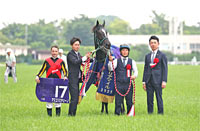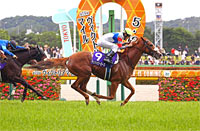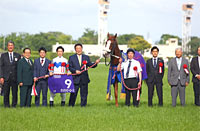2015 News
Data Analysis for the "2015 Victoria Mile (G1)"Spring’s top female decider reaches a milestone Inaugurated in 2006 as a contest for fillies and mares aged 4 and over, the Victoria Mile is the JRA’s newest G1 race. After the inaugural race was won by Dance in the Mood, winner of the 2004 Oka Sho (Japanese 1000 Guineas), victory has belonged to horses with proven ability in graded races for fillies from the ages of 2 and 3 – including Vodka in 2009, Buena Vista in 2010, Apapane in 2011, and Verxina with back-to-back wins in 2013 and 2014. Now let’s sift through results over the last 9 years to find some trends in this race for the crown of strongest female. Mainly graded race winners Of 27 top 3 finishers over the last 9 years, 23 already had experience of winning a graded race held at Tokyo, Nakayama, Kyoto or Hanshin Racecourse. So we should probably discount horses with no experience of winning a JRA graded race, or those with experience only of winning graded races at “local racecourses” (the six JRA racecourses other than the four mentioned above). [Table 1] [Table 1] Performance by experience of winning graded races at Tokyo, Nakayama, Kyoto or Hanshin (last 9 years)
Moreover, of the females with experience of winning graded races held at Tokyo, Nakayama, Kyoto or Hanshin Racecourse, those with experience of winning turf 1,600m graded races at those racecourses have achieved even better success ratios, including a win ratio of 20.0% and a top 2 ratio of 32.5%. When comparing graded race winners, our focus should be on those with experience of winning turf 1,600m graded races like this one. [Table 2] [Table 2] Performance of horses with experience of winning graded races at Tokyo, Nakayama, Kyoto or Hanshin, by experience of winning turf 1,600m graded races at those racecourses (last 9 years)
Check the track record in G1 races Of the nine winners over the last 9 years, all except 2008 winner Asian Winds had previously experienced a top 3 finish in a JRA G1 race. Females with this experience also have relatively high success ratios, including a top 3 ratio of 25.0%. [Table 3] [Table 3] Performance by experience of a top 3 finish in a JRA G1 race (last 9 years)
Again, of the nine winners over the last 9 years, all except 2007 winner Koiuta and 2008 winner Asian Winds had previously experienced being backed as favorite in a JRA G1 race. Females with this experience have even better success ratios, including a top 3 ratio of 50.0%. When comparing past track records, our eye should be on horses with experience of a top 3 finish or backing as favorite in a JRA G1 race. [Table 4] [Table 4] Performance by experience of favoritism in a JRA G1 race (last 9 years)
Track record in turf graded races at Tokyo is also important Of the nine winners over the last 9 years, all except 2008 winner Asian Winds had previously experienced a top 2 finish in a turf graded race at Tokyo Racecourse. Horses with this experience have a top 3 ratio of 35.4%, and easily outperform those without such experience in terms of success ratios. [Table 5] [Table 5] Performance by experience of a top 2 finish in a turf graded race at Tokyo Racecourse (last 9 years)
Again, of the nine winners over the last 9 years, all except 2008 winner Asian Winds had previously experienced being backed among the top two favorites in a turf graded race held at Tokyo Racecourse. Females with this experience are similarly superior, with a top 3 ratio of 37.2%. When comparing past track records, our focus should be on horses with experience of a top 2 finish or backing among the higher favorites in a turf graded race at Tokyo Racecourse, like this one. [Table 6] [Table 6] Performance by experience of backing among the top two favorites in a turf graded race at Tokyo Racecourse (last 9 years)
Watch for runners in the inside brackets Checking the performance by bracket number over the last 9 years, relatively high top 3 ratios have been achieved by horses in brackets “1” and “2”. Last year was no exception, with 3rd favorite Meisho Mambo in bracket 2 coming 2nd and 6th favorite Straight Girl in bracket 1 finishing 3rd. [Table 7] [Table 7] Performance by bracket number (last 9 years)
Incidentally, a look at the performance by bracket number of runners with win odds of 10.0 or more reveals an even bigger gap between those in brackets “1 + 2” and those in brackets “3 to 8” in terms of their top 2 and top 3 ratios. This suggests we should pay close attention to females in the inner brackets, even if their pre-race backing is not so high. [Table 8] [Table 8] Performance by bracket number of horses with win odds of 10.0 or more (last 9 years)
Poor showing by females aged 6 and over Turning next to aggregate performances by age over the last 9 years, no horse aged “7 and over” has seen any success, and none aged “6” has finished in the top two. This race has been contested by some horses aged “6 and over” backed by higher favoritism – including Sweep Tosho in 2007 (6yo, 2nd favorite, finished 9th), Kawakami Princess in 2009 (6yo, 2nd favorite, finished 8th), and Whale Capture in 2014 (6yo, 2nd favorite, finished 4th) – but none has managed a good result. We should be sure to check the runners’ ages this year, too. [Table 9]
[Table 9] Performance by age (last 9 years)
Seek out the winners! All of the last 6 winners were aged “5 or lower”. Other points shared by these six are that they all had a top 2 finish as 3-year-olds in the Oka Sho, and that they had previous experience of winning a turf graded race held at Tokyo Racecourse. And as can be seen from the trends in Table 9 and Tables 1 to 6, age and past track record could also be seen as key points. [Table 10] [Table 10] Winners’ age, finish in the Oka Sho, and highest finish in turf graded races at Tokyo Racecourse (last 6 years)
(Data analysis by Masaya Ibuki) |
|



















